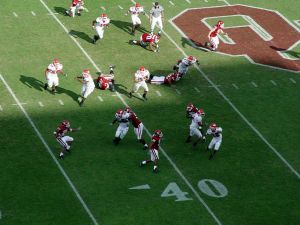Of all the major American spectator sports, listing the champions of Division 1 college football is by far the most head-scratching. In the 138 year-history of collegiate pigskin, 346 different teams have claimed part or all of a “National Title”.
This is because, unlike the NFL with its Superbowl or college basketball with its NCAA Tournament, there has never been a definitive way of crowning college football’s champion. Even the current BCS system — which generally pits the two best teams against each other — has already produced one split championship in its short ten-year history.
But instead of playoffs, the college football powers-that-be have long been content to let opinion polls and mathematical algorithms determine the best team each year. The result has been a gallery of champions that resembles more a wild west saloon fight than a hallowed hall of distinction.
The list of champions includes a lot of names you would expect such as Notre Dame with 21 National Titles, Oklahoma with 17 and Michigan and USC with 16 a piece. But way at the top of the list are Princeton with 28 and Yale with 27.
What?
Yes, well — as it turns out, college football got its start in New Jersey when Rutgers took on Princeton in 1869. Only two games were played that season, both between the New Jersey schools. And true to the college football spirit, with each team dropping a game to the other to finish the year 1-1, they also had to split the 1869 National Title.
It would have been so simple, wouldn’t it, to have played one more game to decide a true National Champion. But no. The precedent was set for the next 137 years of disputes.
Princeton and Rutgers soon added the Columbia Lions to their slate, with Yale joining the club in 1873. Through the decades of the 1870s and much of the 1880s, a few other East Coast schools joined in, but it was not until the late 1880s that the sport rapidly transformed from a strictly Northeastern phenomenon to a considerably more national affair. Northwestern, Wisconsin, Minnesota , Illinois, Michigan and the University of Chicago all joined the fray in the early 1890s marking an aggressive expansion of the sport west of the Appalachians. By the turn of the century, over 60 colleges were participating in football in an area stretching from the eastern seaboard all the way to the plains states.
It was in these early years that Yale and Princeton racked up National Title after National Title. The Bulldogs and Tigers were unholy gridiron terrors in those days, playing slates of 15 to 16 games and sometimes blanking every single opponent on the schedule while pasting their competition for 10, 11 or 12 touchdowns per game. Wesleyan University was a particularly hapless victim of the “Big 2”, dropping games to the Bulldogs and Tigers by scores of over 100 to zero.
But there are several problems with counting all these early “champions” in with the LSUs, Floridas and Texases of today.
The first is that, despite the wide swath of the nation represented by schools in the early years of college football, teams rarely played anybody outside their immediate vicinity. That was out of practicality, of course. Consider that when the University of Nebraska first fielded a Cornhusker team in 1890, pioneers had been crossing the plains in schooners only 10 years before. Hitting the road was not an easy thing to do for 19th Century gridiron squads.
Secondly, there was no consistency in schedule length. Sometimes teams played a slate of 12 games, sometimes they played just 2. It was all rather willy nilly. And not every team on the schedule was necessarily a college team. At the turn of the century, the Michigans, Nebraskas and Notre Dames had to fill out the slate with high school teams. To which they sometimes lost.
Another problem with comparing the champions of yore to those of today, is the gray area as to how much the sport played 100 years ago resembled the one competed in now. No bowl games, no spread offenses — heck, not even any face masks. And beyond those, the scores of some of the games looked pretty goofy. In 1880, for example, Harvard beat Ottawa 2-1. Penn lost to Princeton 0-1. Rutgers beat Stevens Tech 5-1.
Were these teams playing football or soccer?
Turns out that in the early history of the game, safeties were considered 1 point. Field goals were 2 points. And so were touchdowns. You might ask yourself, then why not kick a field goal every time instead of going for a touchdown? Well, because PATs were worth 4 points.
Crazy, I know. Apparently kicking a ball through the uprights was considerably harder for 19th Century athletes than it was to move a ball across the goal line.
The point system changed several times in the first 40 years of college football — field goals were worth 5 points for several seasons, while touchdowns were only worth 4. Penalties also gave points to opposing teams during the 19th Century.
The current base point system of 2 points for safeties, 6 points for touchdowns, 3 points for field goals, 1 point for PATs and 2 points for conversions was not implemented until 1912.
So where does all this leave us in terms of compiling a true college football National Champion list?
Those 19th Century and early 20th Century football titans were certainly champions of something. But they were not “national” champions. Not when the majority of games played were between schools whose campuses sat less than 500 miles apart. Not when a slate of 3, 4 or 5 games could be considered a “full season”. Not when there was no such thing as a “bowl” game, much less a “post season”. Not when the game was so different from what we know today that field goals were worth more than touchdowns.
So when did the sport finally evolve into the coast-to-coast, smash-mouth, big-money competition of now? Probably not truly until the 1960s. But by 1920, the makings of modern college football had at least climbed out of the primordial ooze as something fans in 2008 could easily recognize. The United States’ transportation infrastructure in 1920 had evolved such that cross-country football meetings (though not nearly as common as today) were not only possible, but were becoming frequent. The 1902 Tournament East-West football game between Michigan and Stanford was an early precursor to both bowl games and truly cross-country competition. But football matches between such far-flung schools were a rarity until the late 1910s. And real bowl games would not come into existence until 1923 when the Rose Bowl made its debut.
Picking a National Champion became a little more definitive in 1936 when the AP poll started an annual list of team rankings. While there were other polls and even mathematical systems cooked up prior to the AP poll, its uniqueness in gathering a consensus among sports writers and its longevity have made it a gold standard in selecting National Titles. Since then, in addition to the AP, the UPI poll, the USA Today Coaches poll and the BCS poll have all become regarded as legitimate consensus champion selectors. Any team to finish atop any of these four polls (even if two or more polls differ) is a true college football National Champion.
And what about teams before 1936?
Well, as stated before, the very early years of college football are too parochial and to structurally standardless to be compared to modern seasons. 1920 may not be the exact first year that all the relative criteria fell into place and it may be somewhat arbitrary, but in my book, I would mark down the 1920 California Golden Bears as the first true college football National Champion. They went undefeated in 9 games. They played 5 out-of-state foes including a previously unbeaten Ohio State team and they found themselves scored upon only twice during the entire season.
Here is the list as I see it of which college football teams can be considered “true” National Champions.
1920 California
1921 Notre Dame
1922 California
1923 Illinois
1924 Notre Dame
1925 Alabama
1926 Stanford
1927 Army
1928 Georgia Tech
1929 USC
1930 Notre Dame
1931 USC
1932 USC
1933 USC
1934 Alabama
1935 SMU
1936 Minnesota
1937 Pittsburgh
1938 TCU
1939 Texas A&M;
1940 Minnesota
1941 Minnesota
1942 Ohio State
1943 Notre Dame
1944 Army
1945 Army
1946 Notre Dame
1947 Notre Dame
1948 Michigan
1949 Notre Dame
1950 Oklahoma
1951 Tennessee
1952 Michigan State
1953 Maryland
1954 Ohio State, UCLA
1955 Oklahoma
1956 Oklahoma
1957 Auburn, Ohio State
1958 LSU
1959 Syracuse
1960 Minnesota
1961 Alabama
1962 USC
1963 Texas
1964 Alabama
1965 Alabama, Michigan State
1966 Notre Dame
1967 USC
1968 Ohio State
1969 Texas
1970 Nebraska, Texas
1971 Nebraska
1972 USC
1973 Notre Dame, Alabama
1974 Oklahoma, USC
1975 Oklahoma
1976 Pittsburgh
1977 Notre Dame
1978 Alabama, USC
1979 Alabama
1980 Georgia
1981 Clemson
1982 Penn State
1983 Miami, FL
1984 BYU
1985 Oklahoma
1986 Penn State
1987 Miami, FL
1988 Notre Dame
1989 Miami, FL
1990 Colorado, Georgia Tech
1991 Miami, FL, Washington
1992 Alabama
1993 Florida State
1994 Nebraska
1995 Nebraska
1996 Florida
1997 Michigan, Nebraska
1998 Tennessee
1999 Florida State
2000 Oklahoma
2001 Miami, FL
2002 Ohio State
2003 USC, LSU
2004 USC
2005 Texas
2006 Florida
2007 LSU
Total number of titles won by individual teams:
11 National Titles
Notre Dame and USC
10 National Titles
Alabama
7 National Titles
Oklahoma
5 National Titles
Miami, Nebraska, Ohio State
4 National Titles
Minnesota and Texas
3 National Titles
LSU and Army
2 National Titles
California, Florida, Florida State, Georgia Tech, Michigan, Michigan State, Penn State, Pittsburgh, Tennessee, Texas A&M;
1 National Title
Auburn, BYU, Clemson, Colorado, Georgia, Illinois, Maryland, SMU, Stanford, Syracuse, TCU, UCLA, Washington






